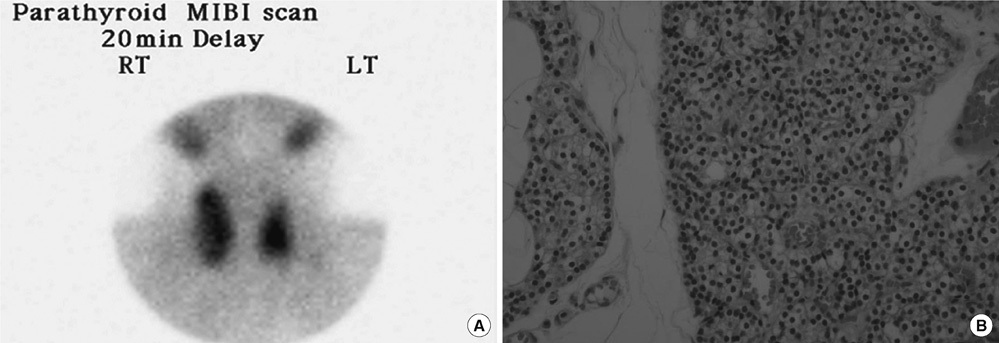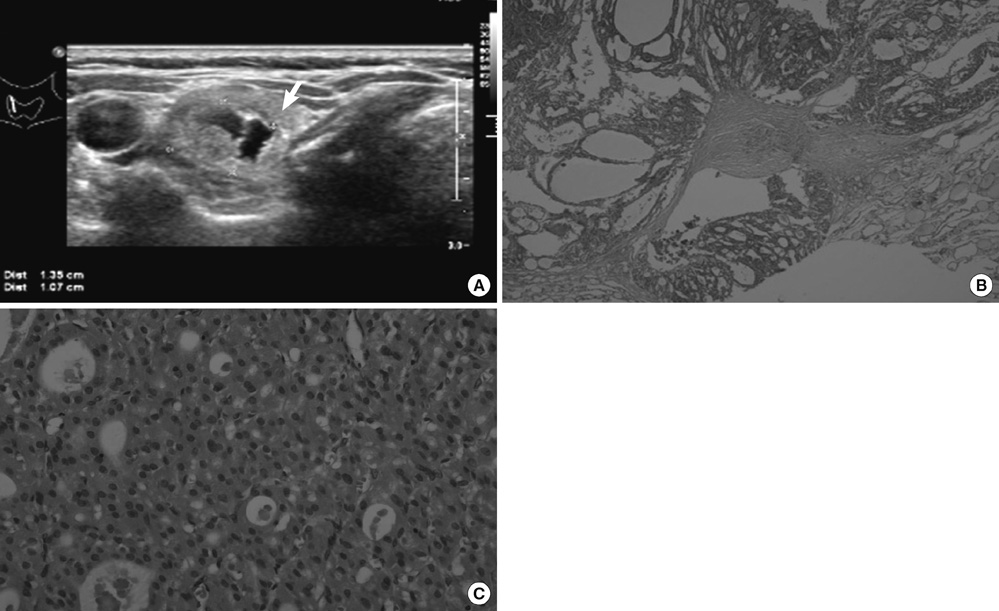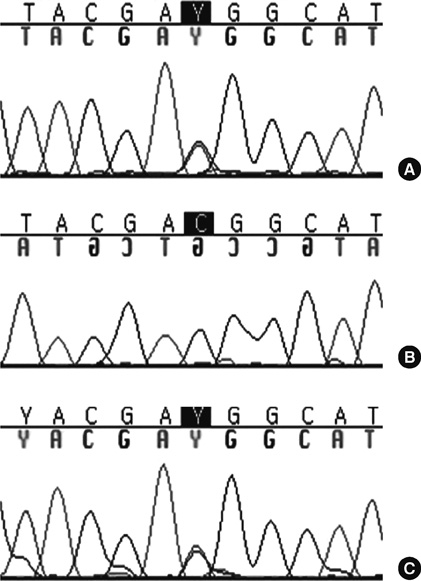J Korean Med Sci.
2012 May;27(5):560-564. 10.3346/jkms.2012.27.5.560.
A Rare Case of Primary Hyperparathyroidism Associated with Primary Aldosteronism, Hurthle Cell Thyroid Cancer and Meningioma
- Affiliations
-
- 1Department of Internal Medicine, Eulji University School of Medicine, Seoul, Korea. kimhj@eulji.ac.kr
- 2Department of General Surgery, Eulji University School of Medicine, Seoul, Korea.
- 3Department of Pathology, Eulji University School of Medicine, Seoul, Korea.
- KMID: 1372802
- DOI: http://doi.org/10.3346/jkms.2012.27.5.560
Abstract
- Multiple endocrine neoplasia type 1 (MEN1) syndrome includes varying combinations of endocrine and non-endocrine tumors. There are also a considerable number of atypical MEN1 syndrome. In this case, a 68-yr-old woman was referred to the Department of Endocrinology for hypercalcemia. Five years ago, she had diagnosed as primary hyperaldosteronism and now newly diagnosed as parathyroid hyperplasia with laboratory and pathologic findings. Hurthle-cell thyroid cancer was also resected during the parathyroid exploration and small meningioma was found on brain MRI. Her general condition has markedly improved and her adrenal mass and meningioma are being closely observed now. We could find the loss of heterozygosity of the MEN1 locus in parathyroid glands, suggesting a MEN1-related tumor, but not a germline mutation. Considering a variety of phenotypic expression and a limitation of current molecular analysis, periodic follow up will be needed in patients with a MEN1-like phenotype.
MeSH Terms
-
Aged
Base Sequence
Brain/radionuclide imaging
Female
Humans
Hyperaldosteronism/complications/*diagnosis
Hyperparathyroidism, Primary/*diagnosis/etiology/pathology
Loss of Heterozygosity
Magnetic Resonance Imaging
Meningeal Neoplasms/complications/*diagnosis/radionuclide imaging
Meningioma/complications/*diagnosis/radionuclide imaging
Mutation
Parathyroid Glands/pathology
Proto-Oncogene Proteins/genetics/metabolism
Sequence Analysis, DNA
Thyroid Neoplasms/complications/*diagnosis/pathology
Tomography, X-Ray Computed
Figure
Reference
-
1. Marsh DJ, Gimm O. Multiple endocrine neoplasia: types 1 and 2. Adv Otorhinolaryngol. 2011. 70:84–90.2. Brandi ML, Gagel RF, Angeli A, Bilezikian JP, Beck-Peccoz P, Bordi C, Conte-Devolx B, Falchetti A, Gheri RG, Libroia A, et al. Guidelines for diagnosis and therapy of MEN type 1 and type 2. J Clin Endocrinol Metab. 2001. 86:5658–5671.3. Langer P, Cupisti K, Bartsch DK, Nies C, Goretzki PE, Rothmund M, Röher HD. Adrenal involvement in multiple endocrine neoplasia type 1. World J Surg. 2002. 26:891–896.4. Asgharian B, Chen YJ, Patronas NJ, Peghini PL, Reynolds JC, Vortmeyer A, Zhuang Z, Venzon DJ, Gibril F, Jensen RT. Meningiomas may be a component tumor of multiple endocrine neoplasia type 1. Clin Cancer Res. 2004. 10:869–880.5. Guo SS, Sawicki MP. Molecular and genetic mechanisms of tumorigenesis in multiple endocrine neoplasia type-1. Mol Endocrinol. 2001. 15:1653–1664.6. Schussheim DH, Skarulis MC, Agarwal SK, Simonds WF, Burns AL, Spiegel AM, Marx SJ. Multiple endocrine neoplasia type 1: new clinical and basic findings. Trends Endocrinol Metab. 2001. 12:173–178.7. Thakker RV. Multiple endocrine neoplasia type 1 (MEN1). Best Pract Res Clin Endocrinol Metab. 2010. 24:355–370.8. Beckers A, Abs R, Willems P, Van der Auwera B, Kovacs K, Reznik M, Stevenaert A. Aldosterone-secreting adrenal adenoma as part of multiple endocrine neoplasia type 1 (MEN1): loss of heterozygosity for polymorphic chromosome 11 deoxyribonucleic acid markers, including the MEN1 locus. J Clin Endocrinol Metab. 1992. 75:564–570.9. Iida A, Blake K, Tunny T, Klemm S, Stowasser M, Hayward N, Gordon R, Nakamura Y, Imai T. Allelic losses on chromosome band 11q13 in aldosterone-producing adrenal tumors. Genes Chromosomes Cancer. 1995. 12:73–75.10. Uchino S, Noguchi S, Sato M, Yamashita H, Yamashita H, Watanabe S, Murakami T, Toda M, Ohshima A, Futata T, et al. Screening of the MEN1 gene and discovery of germ-line and somatic mutations in apparently sporadic parathyroid tumors. Cancer Res. 2000. 60:5553–5557.11. Waldmann J, Bartsch DK, Kann PH, Fendrich V, Rothmund M, Langer P. Adrenal involvement in multiple endocrine neoplasia type 1: results of 7 years prospective screening. Langenbecks Arch Surg. 2007. 392:437–443.12. Skogseid B, Larsson C, Lindgren PG, Kvanta E, Rastad J, Theodorsson E, Wide L, Wilander E, Oberg K. Clinical and genetic features of adrenocortical lesions in multiple endocrine neoplasia type 1. J Clin Endocrinol Metab. 1992. 75:76–81.13. Rossi E, Sani C, Perazzoli F, Casoli MC, Negro A, Dotti C. Alterations of calcium metabolism and of parathyroid function in primary aldosteronism, and their reversal by spironolactone or by surgical removal of aldosterone-producing adenomas. Am J Hypertens. 1995. 8:884–893.14. Desai D, McPherson LA, Higgins JP, Weigel RJ. Genetic analysis of a papillary thyroid carcinoma in a patient with MEN1. Ann Surg Oncol. 2001. 8:342–346.15. Vortmeyer AO, Lubensky IA, Skarulis M, Li G, Moon YW, Park WS, Weil R, Barlow C, Spiegel AM, Marx SJ, et al. Multiple endocrine neoplasia type 1: atypical presentation, clinical course, and genetic analysis of multiple tumors. Mod Pathol. 1999. 12:919–924.16. Kim HJ, Park JS, Kim CS, Kang ES, Cha BS, Lim SK, Kim KR, Lee HC, Ahn CW. A case of multiple endocrine neoplasia type 1 combined with papillary thyroid carcinoma. Yonsei Med J. 2008. 49:503–506.17. Bäcklund LM, Grandér D, Brandt L, Hall P, Ekbom A. Parathyroid adenoma and primary CNS tumors. Int J Cancer. 2005. 113:866–869.18. Marinoni I, Pellegata NS. p27kip1: a new multiple endocrine neoplasia gene? Neuroendocrinology. 2011. 93:19–28.19. Molatore S, Marinori I, Lee M, Pulz E, Ambrosio MR, degli Uberti EC, Zatelli MC, Pellegata NS. A novel germline CDKN1B mutation causing multiple endocrine tumors: clinical, genetic and functional characterization. Hum Mutat. 2010. 31:E1825–E1835.20. Agarwal SK, Mateo CM, Marx SJ. Rare germline mutations in cyclin-dependent kinase inhibitor genes in multiple endocrine neoplasia type 1 and related states. J Clin Endocrinol Metab. 2009. 94:1826–1834.
- Full Text Links
- Actions
-
Cited
- CITED
-
- Close
- Share
- Similar articles
-
- Intrathyroidal Parathyroid Hyperplasia Misdiagnosed as Hurthle Cell Neoplasm
- Primary Hyperparathyroidism, Concomitant Thyroid Papillary and Follicular Carcinomas on the Background of Hashimoto's: Interplay?
- Coexistence of Parathyroid and Papillary Thyroid Carcinoma
- A Case of Familial Isolated Primary Hyperparathyroidism with a Novel Gene Mutation
- Synchronous Parathyroid Adenoma and Papillary Thyroid Carcinoma






